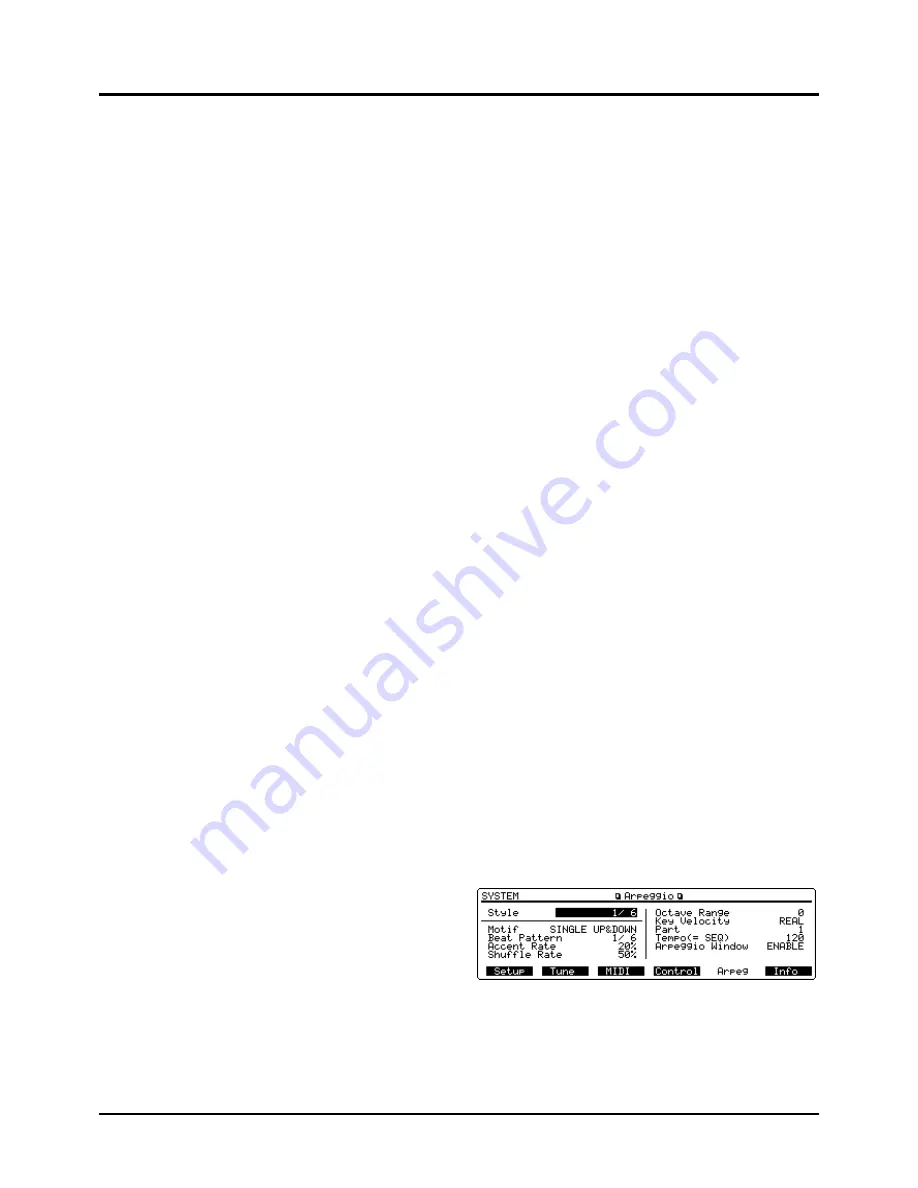
36
Playing an arpeggio over a preset key-
board area
As soon as you press [ARPEGGIO] to turn the Arpeggiator
on, the keyboard will be set to play arpeggios so convention-
al keyboard playing is no longer possible.
If you split the keyboard into two different areas, you can
use one area for normal playing and the other for playing
arpeggios. This setting, for instance, allows you to play
arpeggios with the left hand and a melody with the right
hand.
<Procedure>
❶
Press [PERFORM] to call up the Play display (PER-
FORM).
❷
If you have selected a Single Performance, set the Key
Mode parameter (PERFORM/Common/Common) to
LAYER.
❸
Set the Part parameter (SYSTEM/Arpeg/Arpeggio) to
the Part you want for playing arpeggio.
❹
Set the Local Switch parameter (PERFORM/MIDI/
Part MIDI) ON for the Part you want to hear.
❺
Press [F2] (K.Range) to call up the Part Key Range
Lower:Upper display (PERFORM/K.Range).
❻
Set the Switch parameter (PERFORM/K.Range) ON.
❼
Move the cursor to the Part you want playing arpeg-
gio, and set the key range.
❽
Move the cursor to another Part (that doesn’t need to
play arpeggio), and set the key range so that it does not
overlap with the key range for playing arpeggio.
❾
After you finish settings, call up the Play display (PER-
FORM) again and play a chord.
✳
If you play an arpeggio using Layer Performance but
without setting key range, the chords will sound for all
Parts except for the specified Part.
Holding an arpeggio
If you play an arpeggio while pressing the hold pedal, the
arpeggio will continue to be played even if you release the
chord.
<Procedure>
❶
Connect an optional pedal switch to the HOLD jack.
❷
Play a chord while pressing the hold pedal.
❸
To play another chord, release the pedal, press it again
as you play the next chord.
Simulating a guitar cutting technique
You can simulate a guitar cutting technique by following the
procedure below. By using the Sound Palette, it is also possi-
ble to apply a wah effect as you play.
<Procedure>
❶
Select a guitar Patch.
❷
Set the Style parameter (SYSTEM/Arpeg/Arpeggio) to
RHYTHM GTR B, RHYTHM GTR C, RHYTHM GTR D
or RHYTHM GTR E.
❸
Press [FILTER/ENV] so the indicator lights.
❹
Move the CUTOFF slider or RESO slider while you
play a chord.
Playing an arpeggio from an external MIDI
device
The XP-80 can also produce arpeggios with incoming Note
messages from an external MIDI device.
<Procedure>
❶
Connect the XP-80’s MIDI IN connector and the MIDI
OUT connector of an external MIDI device with a
MIDI cable.
❷
Press [SYSTEM], then hold down MIDI [F3] until the
MIDI Param 1 will appear.
❸
Set the Remote Keyboard Sw parameter (SYSTEM/
MIDI/MIDI Param 1) ON.
❹
Play the external MIDI device.
Creating an arpeggio pattern
There are a total of 10 parameters that can be set for the
Arpeggiator, but the most important is the Style parameter
setting. The arpeggio pattern is largely determined by this
setting.
When you set the Style parameter, the Motif, Beat Pattern,
Accent Rate and Shuffle Rate parameters will automatically
be set to optimum settings. This allows you to call up the
most appropriate pattern simply by selecting the arpeggio
style. After selecting the style, you can also set Octave Range
and Key Velocity parameters, etc. In most cases, you’ll speci-
fy the pattern in this way.
If this selection does not provide the pattern you want, mod-
ify the settings of the Motif, Beat Pattern, Accent Rate and
Shuffle Rate parameters to add variations to the style as
desired.
✳
Motif, Beat Pattern, Accent Rate and Shuffle Rate set-
tings will be lost if you select another style or turn the
power off. These settings cannot be saved. Settings of
other parameters (except the Tempo parameter) can be
stored into system memory.
✳
It is possible to store just one style into the system
memory. Set the Style parameter to LIMITLESS then
specify the Motif, Beat Pattern, Accent Rate and Shuffle
Rate parameters as you like.
<Procedure>
❶
Make sure that the Arpeggio window is open.
❷
Press [F5] (Detail) to call up the Arpeggio display.
You can also call up this display by pressing [SYSTEM] then
[F5] (Arpeg).
✳
For details regarding each parameter, refer to
“Arpeggio display” (p.93)
❸
Move the cursor to “Style” and specify the style you
want.
❹
Move the cursor to “Motif” and specify the order in
which the notes of the chord will be played.
Chapter 2. Playing
Summary of Contents for XP-60
Page 245: ...245 ...






























